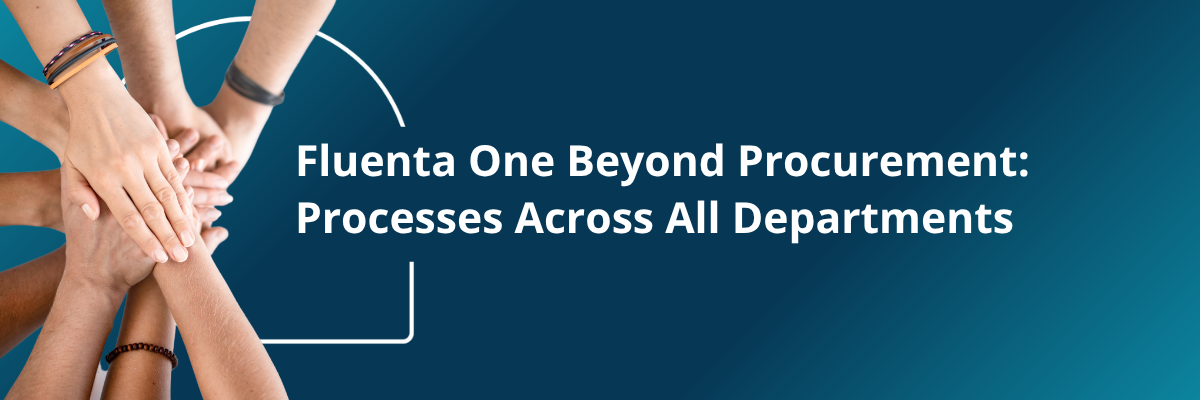

Modern enterprises face a significant challenge. While digitalization advances in every area, different departments often operate as isolated islands, each with their own systems and processes. Procurement, HR, quality assurance, legal, and facility management all work in separate software solutions that rarely—if ever—communicate with each other.
The Fluenta One platform provides a solution to precisely this challenge: an integrated, customizable system with artificial intelligence and flexible workflows that redefines the concept and practice of workflow management.
Fluenta One's strength lies in thinking not in pre-built modules, but in processes. This approach makes it possible to model virtually any business process within the system. There's no need for compromises or adapting your operations to fit the software - Fluenta One maps your unique organizational processes exactly as they function in reality.
While Fluenta Europe has traditionally specialized in procurement processes, the Fluenta One platform extends far beyond this domain. Let's look at concrete examples of how it can be applied across different business functions:
At a multinational company, the HR department deals with these daily challenges:
With Fluenta One, all of this can be managed in a single, transparent workflow. From the moment a request arrives, the system automatically guides the process through approvals, notifies stakeholders, manages documents, and tracks deadlines. The result: a recruitment process that previously took 3-4 weeks is reduced to 10-14 days, while every step remains documented and auditable.
Legal departments often drown in a sea of contracts. For example, at a large energy company, they need to:
The legal team can build their own contract management workflow that automatically alerts them to expirations, handles approvals, and ensures that every contract modification is properly documented.
Imagine a B2B company with complex sales processes:
The platform can unite these processes in a single system. AI agents can support quote preparation, stakeholders receive notifications upon approval, internal policy compliance is verified, and the entire process is documented. With these automations, processes that previously took weeks can be reduced to just a few days.
Precision and traceability are critical in quality assurance. A pharmaceutical industry example:
During the digitalization of audit processes, Fluenta One:
The sophisticated audit and logging system automatically records every access and modification, ensuring full compliance with strict regulations. This is especially important in industries where compliance isn't optional—it's a vital requirement.
Perhaps Fluenta One's greatest strength is that it doesn't want to operate as an isolated island. The API-first architecture means the platform is fundamentally designed to communicate with other systems.
Fluenta One easily connects with any software that has an API, creating a unified ecosystem that boosts productivity—from CRM and ERP systems to collaboration tools.
Fluenta One's process builder uses a no-code/low-code approach that enables business processes to be configured quickly and efficiently. Our experts provide professional guidance, then use the Fluenta One Business Designer to build and customize workflows for your company—whether it's approval steps, automatic notifications, or complex branching. This approach enables rapid, professionally-informed iteration: if a process needs fine-tuning or modification, the low-code/no-code architecture allows implementation in days or even hours without requiring significant IT resources on the client side.
One of the platform's core elements is the embeddable and customizable AI agents that independently handle repetitive, time-consuming tasks.
AI isn't a separate module—it's an integrated part of the platform:
Intelligent Document Processing: AI agents can extract structured data from unstructured documents (PDF invoices, emails, contracts). For an incoming invoice, they automatically identify the supplier, amount, deadline, and accounting data.
Predictive Analytics: AI continuously analyzes historical data and creates forecasts. For example, it warns if a supplier's performance is declining or if a project is likely to exceed budget.
Automated Decision-Making: In simpler cases, decisions can even be delegated to AI. For instance, if desired, an AI agent can automatically approve low-value orders when certain conditions are met.
In an enterprise environment, security is non-negotiable. Fluenta One's Zero Trust architecture ensures:
The intelligent alerting system and customizable reports significantly simplify both internal and external audit processes.
The impact of implementing Fluenta One is measurable and significant:
Companies can implement process changes up to 85% faster than with traditional development cycles.
Fluenta One doesn't promise to solve every business problem. What it does promise is that virtually any business process can be modeled, automated, and integrated on the platform. Whether it's procurement, HR, legal matters, sales, or quality assurance—the common denominator is the process.
Fluenta One's automation framework allows the level of automation to be defined separately for each microprocess. This flexible approach enables gradual transition: companies can progress step by step from fully manual operations toward higher levels of automation, even full autonomy. This isn't a sudden change, but a controlled, gradual transformation where each step creates concrete, measurable value for business operations.